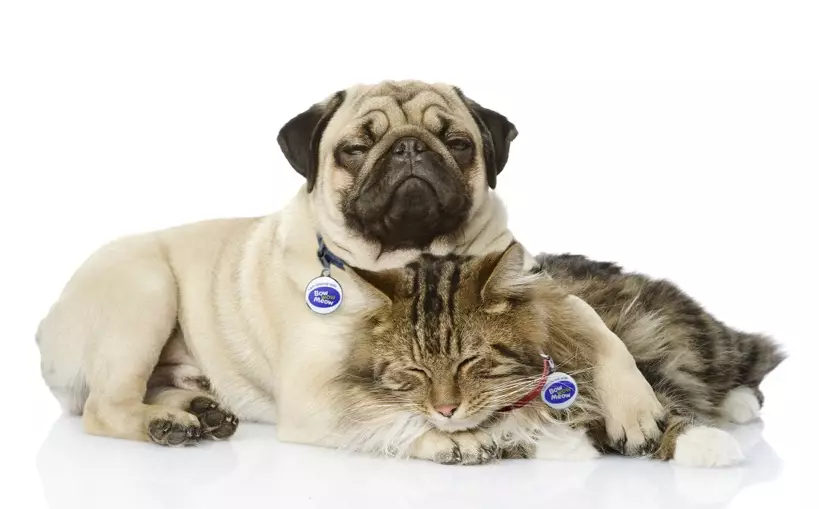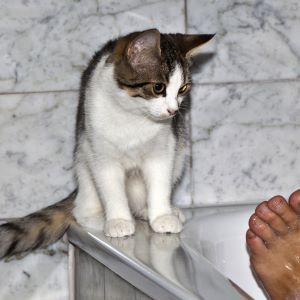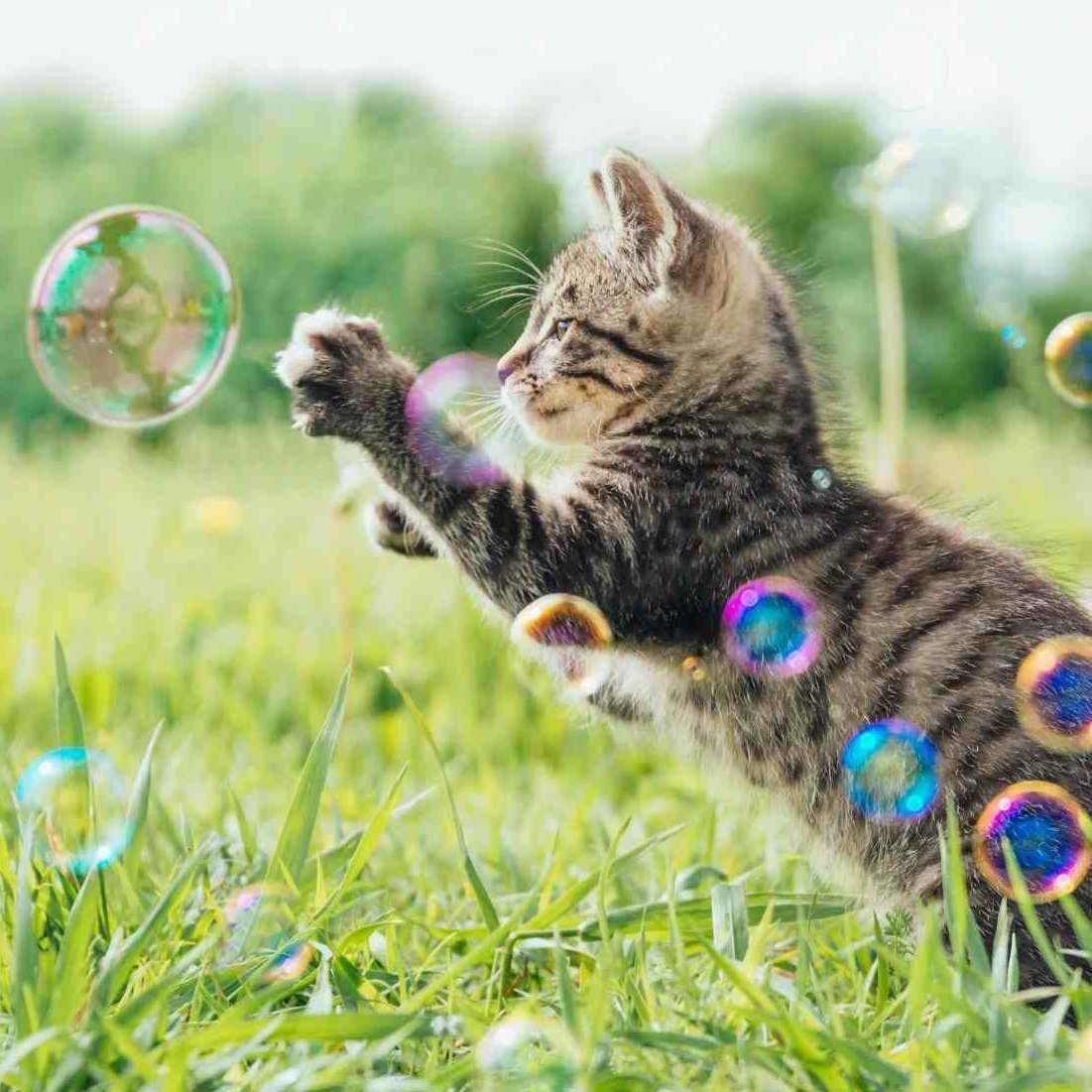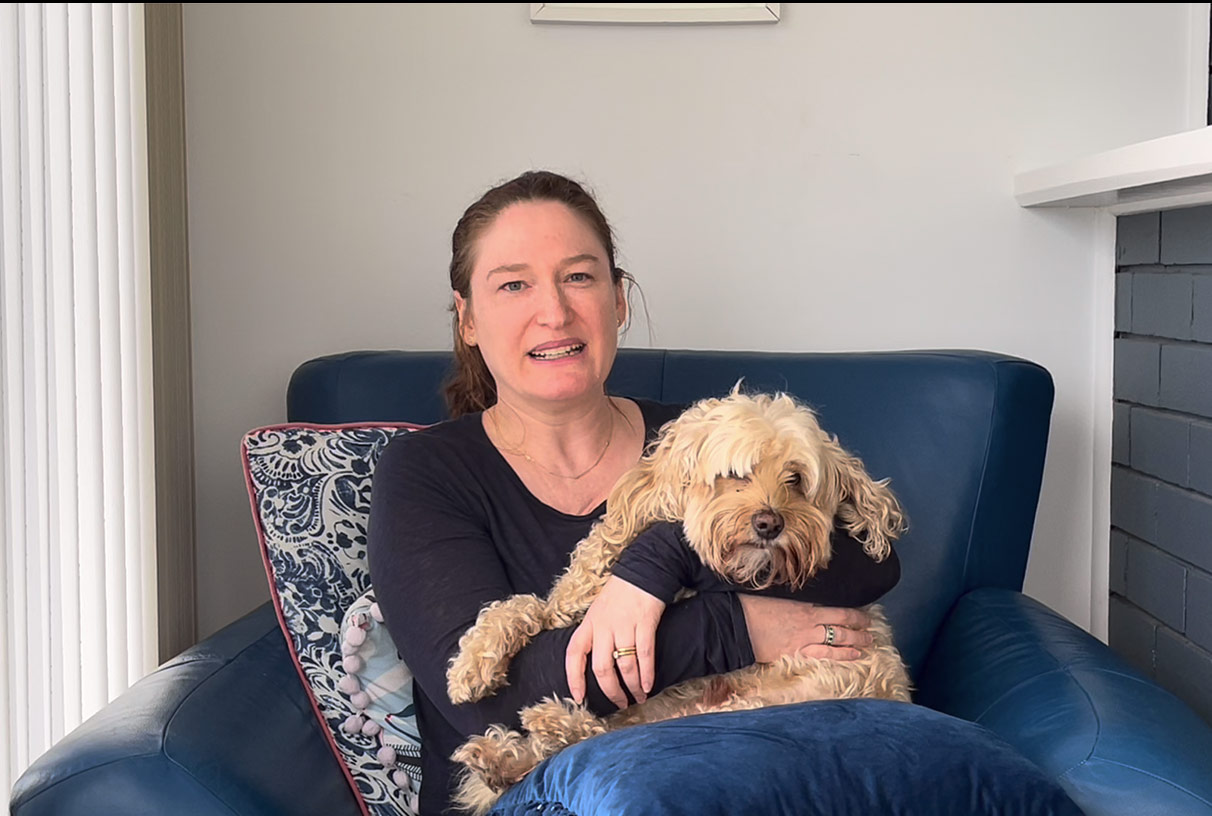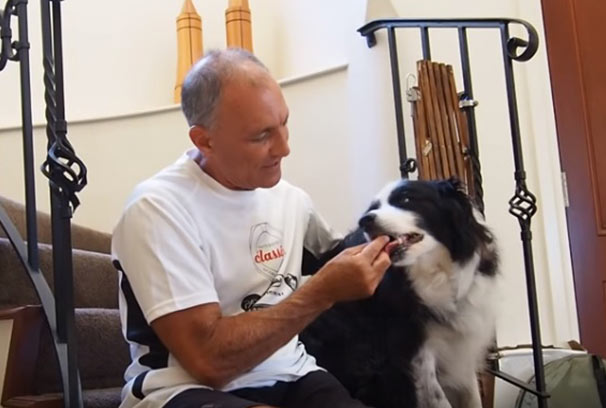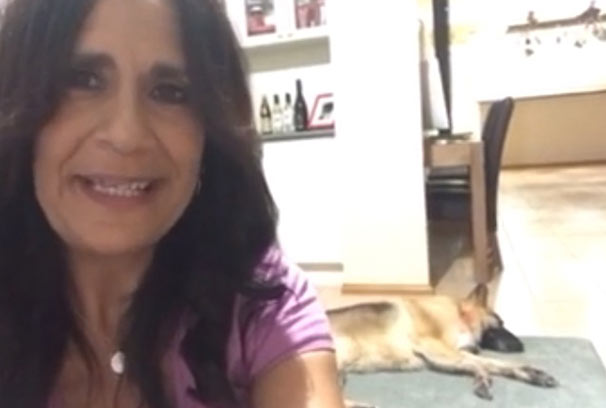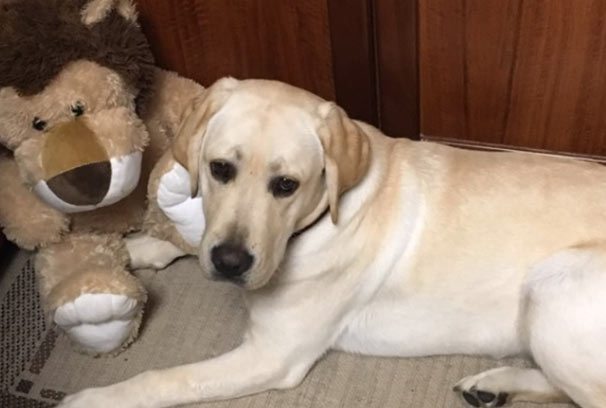Why does my cat keep meowing?

We tend to think of cats as calm and quiet creatures, especially compared to boisterous, barking dogs. But, as many cat owners will attest, felines can also be extremely vocal: meowing you awake at 5am, demanding their dinner at mealtime, ‘talking’ to you while you’re working, or soliloquizing at midnight.
If you’ve wondered why your cat is so chatty or your kitty keeps meowing, you’re not alone. In this article, we’ll dive into the many reasons cats vocalise, what different meows mean, and how to tell if your feline friend is being needy, nosy, or genuinely in need of help.
Why do cats meow?
 Meowing is a natural feline behaviour, but behind it is a message that your cat is trying to convey, and its meaning depends on the situation. Cats often meow to get their humans’ attention, because they’re hungry, seeking interaction, or feeling discomfort.
Meowing is a natural feline behaviour, but behind it is a message that your cat is trying to convey, and its meaning depends on the situation. Cats often meow to get their humans’ attention, because they’re hungry, seeking interaction, or feeling discomfort.
If your usually quiet cat suddenly starts meowing, it’s worth paying attention. While some meowing is normal, excessive or unusual vocalisation may signal an underlying issue, such as pain or distress. On the other hand, playful meows are usually just a way to engage with you.
Here are the three most common reasons behind their vocalisations:
1. Communication needs
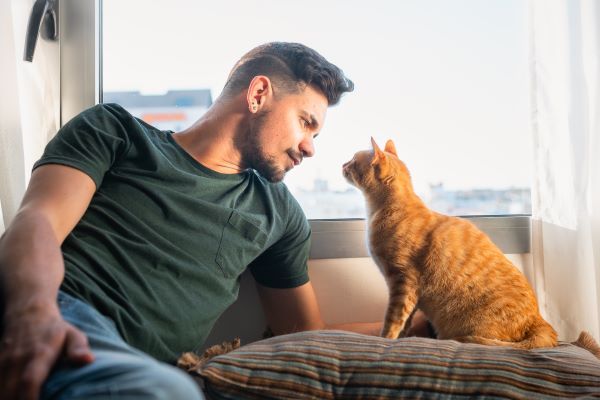
Unlike many animals that vocalise for mating or warning signals, domestic cats primarily use meowing to communicate with humans rather than other cats.
Research from the Journal of Veterinary Science suggests that cats developed meowing as an adaptive behaviour to interact with people, mimicking the frequency range of a human infant’s cry to grab attention.
This is why many cat owners find their pet’s meows difficult to ignore. Cats may meow to signal their needs, such as wanting access to another room, alerting you to an empty food bowl, or even expressing dissatisfaction with a change in routine.
Some breeds, like Siamese cats, are naturally more vocal and engage in extended “conversations” with their owners. If your cat’s meowing seems insistent, they may be trying to convey something specific about their environment or routine.
2. Seeking attention
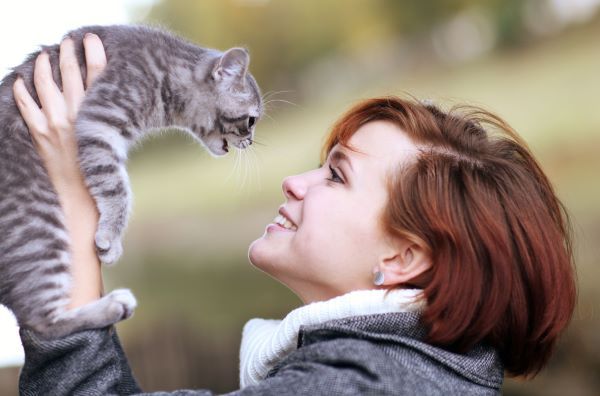
Cats may have a reputation for independence, but they are also social animals that form strong bonds with their humans.
Studies show that cats can distinguish their owner’s voice from a stranger’s and often use vocalisation to initiate interaction. If your cat meows frequently when you enter a room or after you’ve been away, they might simply be seeking a connection.
Some cats also enjoy verbal exchanges, responding to their owners’ voices with meows of their own. Others may meow as a way of reminding you to engage with them, such as through petting, playing, or simply being near them.
If attention-seeking meowing becomes excessive, providing regular play sessions and mental stimulation can help reduce it.
3. Expressing discomfort or hunger

Hunger is a major reason cats meow, especially if feeding time is near.
A study in Current Biology found that some cats add a high-frequency cry to their purring when demanding food. Persistent meowing near the food area likely means your cat is reminding you it’s time to eat.
Beyond hunger, meowing can also signal discomfort or illness. If the vocalisations become more urgent, and prolonged, or are accompanied by lethargy, vomiting, or appetite changes, it may indicate issues like hyperthyroidism, dental pain, or urinary tract infections.
If you’re concerned about any symptoms, check out our guide on how to tell if your cat is sick.
When we take the time to listen and observe, we can better understand why cats meow. Cats meow to communicate needs, seek attention, or express discomfort, and paying attention to their vocalisations and context helps us respond in a way that supports their well-being.
How to understand a cat’s meow
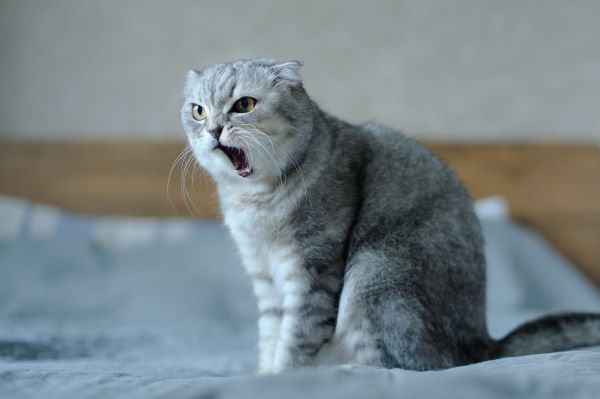
To better understand your cat, it’s essential to distinguish between different types of meows. Observing tone, frequency, context, and body language helps accurately interpret what your cat is trying to communicate. Here’s what you need to know to recognise their different meows.
Tone and frequency
The tone and frequency of your cat’s meow provide valuable insights into their emotional state. A soft, rhythmic meow often signals a polite request for attention, while a loud or persistent meow may indicate distress, urgency, or a more pressing need.
For instance, some cats increase the volume and frequency of their meows when they’re in pain or anxious, while others meow more urgently when they need food or wish to go outside.
Tip: Pay attention to the tone and frequency of your cat’s meows to better understand if they’re seeking affection, feeling distressed, or expressing discomfort.
Examples of types of meows and their meanings:
| Meow type | Description | Common meaning |
| Short, high-pitched ‘meep’ | Brief, upbeat | Greeting or attention-seeking |
| Mid-pitch repeated meows | Neutral tone, persistent | Request for food, play or access |
| Long, drawn-out meow | Elongated and dramatic | Demand or protest, e.g. Let me out! |
| Low-pitched growly meow | Grumbly or moaning | Annoyance, discomfort or complaint |
| High-pitched shriek or yowl | Sharp or loud | Pain, fear or aggression |
| Chirps and trills | Warbling sounds | Friendly greeting |
| Nighttime yowling | Loud and eerie | Disorientation, loneliness or cognitive decline |
Context and environment
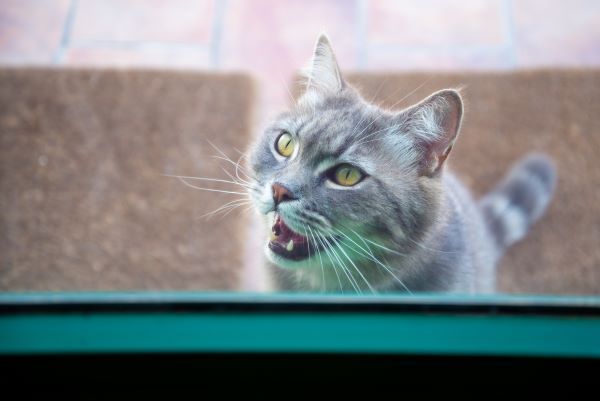
The context in which your cat meows plays a key role in interpreting their behaviour. Here are some typical examples:
- Cats often meow around feeding time or near their food bowl, signalling hunger.
- If your cat meows near a door, they might want to go in or out.
- If the meowing is happening near you while you’re working, they are bored or want attention.
Changes in their environment such as new people, pets, or shifts in routine can also lead to increased meowing as they adjust to new stimuli. A study in Applied Animal Behaviour Science found that the environment significantly impacts feline vocal behaviour, with pet cats vocalising differently from feral cats due to domestication and human interaction.
Tip: Observe the setting where your cat is meowing to understand if it’s a basic need or a response to changes in their environment. Pay attention to the context rather than assuming it’s just about food.
Body language
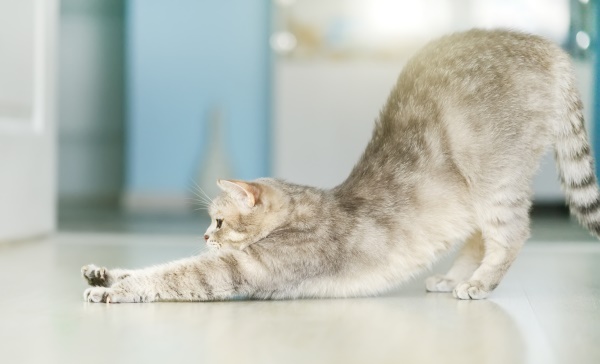
Cats often accompany their vocalisations with body language, which can help you interpret their meows more accurately:
- A relaxed posture with upright ears, a neutral tail, and a soft meow typically means your cat is content and just seeking attention.
- If their tail is up and their ears forward, they are being friendly.
- If their body is tense, ears are flattened, or their tail is twitching, it could indicate stress, irritation, or discomfort.
- An arched back and puffed tail indicates that they are scared or threatened.
Understanding these cues is essential, as cats use body language in combination with vocalisations to convey complex emotional states. Recognising these signs can help you respond appropriately to your cat’s needs.
For more insights on interpreting your cat’s body language, check out our guide on cat tail signs.
Tip: Watch your cat’s body language such as their posture, tail, and ear positions along with their meowing to better gauge their emotional state.
How to stop a cat from meowing
There are many ways to address excessive vocalisation. Here are some strategies on how to stop a cat from meowing:
Provide regular feeding times
One common reason for meowing, especially around certain times of the day, is hunger. Cats tend to vocalise when they’re hungry, and keeping a consistent feeding schedule can help prevent excessive meowing.
If your cat tends to meow frequently around feeding time, try setting a fixed routine for meals to reduce their anxiety about when they’ll be fed.
Ensure adequate play and stimulation
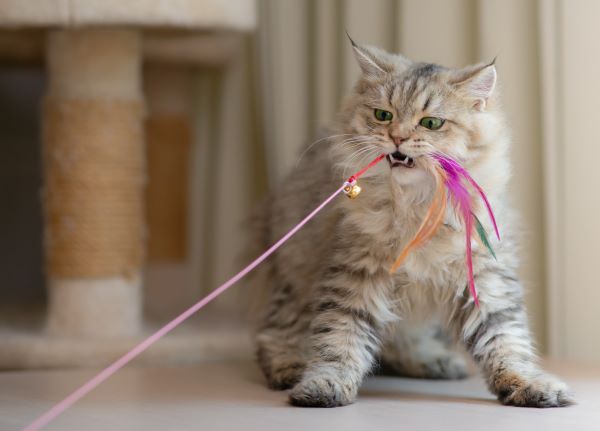
Cats often meow out of boredom or a need for attention. Providing enough mental stimulation, such as interactive toys for cats, climbing trees, or puzzle feeders, can keep your cat entertained and reduce unnecessary meowing.
Play sessions, especially before bed, can help tire them out and encourage them to sleep peacefully through the night.
Establish a calm nighttime routine
If your cat is meowing during the night, they may be feeling lonely or anxious.
Try establishing a calm, predictable nighttime routine. Dim the lights, reduce noise, and provide a cosy sleeping space for your cat.
Cats thrive on routine, and providing a consistent bedtime routine can help them feel secure and reduce nighttime meowing.
Provide a comfortable and safe space
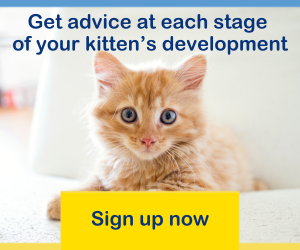 If your cat meows at night, they may be feeling anxious, especially if they’re not used to being alone.
If your cat meows at night, they may be feeling anxious, especially if they’re not used to being alone.
Providing a safe and quiet space with familiar bedding can help your cat feel secure. Additionally, leaving a piece of your clothing or a familiar scent nearby can comfort them during the night.
Ignore unwanted meowing
If your cat meows for attention, it can sometimes reinforce the behaviour.
When they meow excessively, especially for trivial reasons like wanting to be picked up, try ignoring them. Responding to their meows, even with positive attention, can encourage them to vocalise more.
Wait until they stop meowing and then reward them with affection or a treat to reinforce quiet behaviour.
Consult a vet for persistent meowing
If your cat’s meowing becomes persistent, particularly if it seems to be out of character, it’s important to consult a vet.
Excessive vocalisation, especially in older cats, could indicate health issues such as hyperthyroidism or hearing problems. A vet can help rule out any medical conditions and provide advice on managing the behaviour.
Meowing is how your cat expresses their needs, and while not always problematic, excessive or out-of-character meowing should be addressed.
Unsure how serious it is?
Bow Wow Meow policyholders can get access to trusted vet care anytime, anywhere, at no additional cost. Connect to an experienced Australian registered vet via video call, 24/7. Whether it’s providing vet advice, setting up at-home treatment plans, or confirming if you need to visit a vet in person, you can get help when you need it.
Find out more about our pet insurance cover options.
Strengthening your bond with your cat
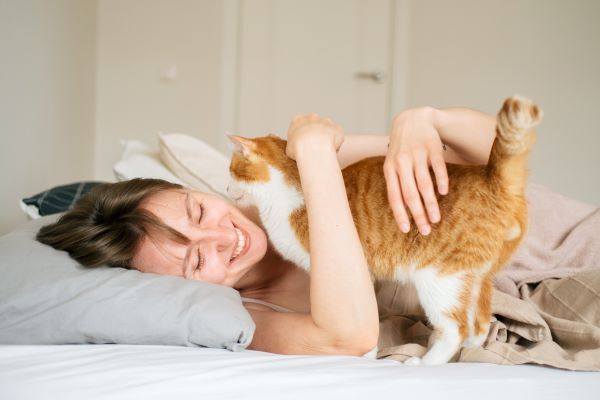
Observing your cat’s behaviour closely helps you understand why your cat keeps meowing and how to manage it.
As their owner, you are best positioned to recognise their unique vocalisations and body language. Over time, you’ll become more attuned to their needs, allowing you to interpret their meows with greater accuracy.
With patience and positive reinforcement, you can address their vocalisations and strengthen your bond. Responding appropriately to their needs will build trust and reinforce your connection.
Learning to interpret their meows and body language, while respecting their boundaries, leads to a deeper, more trusting relationship.
FAQs
Why do cats meow?
Cats meow to communicate with their owners. They use meowing to express various needs, such as hunger, seeking attention, or alerting you to something in their environment. It’s one of the primary ways they interact with humans.
Why is my cat meowing so much?
Excessive meowing can be a sign that your cat has unmet needs, such as hunger, boredom, or a desire for attention. It could also indicate discomfort, stress, or health issues. Pay attention to the context and tone of the meowing to understand the cause.
Why does my cat meow all the time?
If your cat is meowing constantly, it may be trying to communicate something specific, such as wanting food, playtime, or affection. Meowing can also increase when a cat feels stressed or is adjusting to changes in its environment.
Why does my cat meow at night?
Nighttime meowing is often due to boredom, anxiety, or wanting attention. Cats are naturally more active during the night and may vocalise to express their discomfort or desire for companionship. Creating a calming nighttime routine can help reduce nocturnal meowing.
How to stop a cat from meowing?
To stop a cat from meowing excessively, address the cause whether hunger, boredom, or seeking attention. Establish a consistent feeding schedule, provide interactive toys, and create a calm environment. If the meowing seems unusual, consult a vet to rule out health concerns.
Bow Wow Meow Pet Insurance can help protect you and your cat should an unexpected trip to the vet occur.
-
Find out more about our cat insurance options
-
Get an online pet insurance quote
Bow Wow Meow is proud to have been awarded winner of Canstar’s ‘Most Satisfied Customers’ Award in the Pet Insurance category for both 2024 and 2025!
Bow Wow Meow is proud to have been chosen as Product Review’s Pet Insurance Award Winner every year from 2018 to 2025! This is based on 2,995 independent customer reviews (as at 21/01/2025), with an overall rating of 4.3*
Google Review rating = 4.5* (based on 968 reviews)
Trust Pilot rating = 4.6* (based on 531 reviews)
Bow Wow Meow is proud to have been chosen as Product Review’s Pet Insurance Award Winner every year from 2018 to 2025! This is based on 2,995 independent customer reviews (as at 21/01/2025), with an overall rating of 4.3*
Google Review rating = 4.5* (based on 968 reviews)
Trust Pilot rating = 4.6* (based on 531 reviews)
Bow Wow Meow has been chosen as a winner in the Finder Pet Insurance Awards 2024. Finder’s panel of experts analysed over 140 quotes to award our Ultimate Care Plan the winner of the “Pet Insurance – Value” category.


